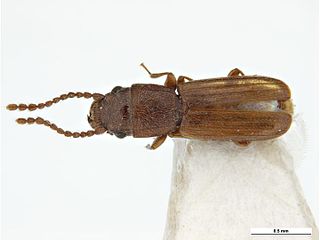
Cryptolestes is a genus of beetles in the family Laemophloeidae. Several species are known as economically important pests of stored products, especially food grains. The four most notorious species are Cryptolestes ferrugineus, Cryptolestes pusilloides, Cryptolestes pusillus, and Cryptolestes turcicus. C. capensis, C. klapperichi, and C. ugandae are less widespread pests. Species in this genus can be hard to distinguish from one another, and definitive identification often requires close examination of the genitalia.

Jacobsoniidae are a family of tiny beetles belonging to Staphylinoidea. The larvae and adults live under bark, in plant litter, fungi, bat guano and rotten wood. There are around 28 described species in three genera:

Silvanidae, "silvan flat bark beetles", is a family of beetles in the superfamily Cucujoidea, consisting of 68 described genera and about 500 described species. The family is represented on all continents except Antarctica, and is most diverse at both the generic and species levels in the Old World tropics.

Clinidium is a genus of wrinkled bark beetles in the subfamily Rhysodinae. Most species are Neotropical, but some occur further north in North America and there is also one species in Europe and one in Japan. Two species are known from Miocene amber.

Rhyzodiastes is a genus of beetles in the family Carabidae, containing the following species:

Kaveinga is a genus of wrinkled bark beetles in the family Carabidae.

Laemophloeus is a genus of beetles; it is the type genus of the family Laemophloeidae. The genus has been almost completely reviewed in modern times.
Passandrophloeus is a genus of beetles in the family Laemophloeidae, containing the following species:

Placonotus is a genus of beetles in the family Laemophloeidae. There are 40 currently recognized species, known from all continents except Antarctica. Placonotus species are small (~2mm), elongate, flattened beetles, characterized by long filiform antennae, presence of a frontoclypeal suture, open anterior coxal cavities, and broadly rounded intercoxal process of abdominal ventrite III. Males have the 8th abdominal segment modified to form claspers used during mating. Adults and larvae are found under dead bark, where they feed on fungi. Currently recognized species are:
Rhinophloeus is a genus of beetles in the family Laemophloeidae, containing the following species:

Psammoecus is a genus of beetles in the family Silvanidae, containing the following species:

Ahasverus is a genus of beetles in the family Silvanidae.

Airaphilus is a genus of beetles in the family Silvanidae, containing the following species:

Monanus is a genus of beetles in the family Silvanidae, containing the following species:

Nausibius is a genus of beetles in the family Silvanidae, containing the following species:
Parasilvanus is a genus of beetles in the family Silvanidae, containing the following species:

Silvanoprus is a genus of beetles in the family Silvanidae, containing the following species:
Europs is a genus of beetles in the family Monotomidae, containing the following species:
Hapalips is a genus of pleasing fungus beetles in the family Erotylidae. There are about 12 described species in Hapalips.
Deretaphrus is a genus of dry bark beetles in the family Bothrideridae. A taxonomic revision of the genus published in 2013 listed 25 species, which exhibit a disjunct distribution. There are 22 species of the genus described from Australia, with single species also being found in each of New Caledonia, Bolivia, and North America.













